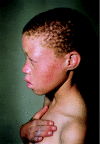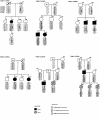In Southern Africa, brown oculocutaneous albinism (BOCA) maps to the OCA2 locus on chromosome 15q: P-gene mutations identified
- PMID: 11179026
- PMCID: PMC1274491
- DOI: 10.1086/318800
In Southern Africa, brown oculocutaneous albinism (BOCA) maps to the OCA2 locus on chromosome 15q: P-gene mutations identified
Abstract
In southern Africa, brown oculocutaneous albinism (BOCA) is a distinct pigmentation phenotype. In at least two cases, it has occurred in the same families as tyrosinase-positive oculocutaneous albinism (OCA2), suggesting that it may be allelic, despite the fact that this phenotype was attributed to mutations in the TYRP1 gene in an American individual of mixed ancestry. Linkage analysis in five families mapped the BOCA locus to the same region as the OCA2 locus (maximum LOD 3.07; theta=0 using a six-marker haplotype). Mutation analysis of the human homologue of the mouse pink-eyed dilution gene (P), in 10 unrelated individuals with BOCA revealed that 9 had one copy of the 2.7-kb deletion. No other mutations were identified. Additional haplotype studies, based on closely linked markers (telomere to centromere: D15S1048, D15S1019, D15S1533, P-gene 2.7-kb deletion, D15S219, and D15S156) revealed several BOCA-associated P haplotypes. These could be divided into two core haplotypes, suggesting that a limited number of P-gene mutations give rise to this phenotype.
Figures


Similar articles
-
Rufous oculocutaneous albinism in southern African Blacks is caused by mutations in the TYRP1 gene.Am J Hum Genet. 1997 Nov;61(5):1095-101. doi: 10.1086/301603. Am J Hum Genet. 1997. PMID: 9345097 Free PMC article.
-
Identification of P gene mutations in individuals with oculocutaneous albinism in sub-Saharan Africa.Hum Mutat. 2000;15(2):166-72. doi: 10.1002/(SICI)1098-1004(200002)15:2<166::AID-HUMU5>3.0.CO;2-Z. Hum Mutat. 2000. PMID: 10649493
-
An intragenic deletion of the P gene is the common mutation causing tyrosinase-positive oculocutaneous albinism in southern African Negroids.Am J Hum Genet. 1995 Mar;56(3):586-91. Am J Hum Genet. 1995. PMID: 7887411 Free PMC article.
-
The pink-eyed dilution gene and the molecular pathogenesis of tyrosinase-positive albinism (OCA2).J Dermatol. 1999 Nov;26(11):738-47. doi: 10.1111/j.1346-8138.1999.tb02085.x. J Dermatol. 1999. PMID: 10635616 Review. No abstract available.
-
Molecular basis of oculocutaneous albinism.J Invest Dermatol. 1994 Nov;103(5 Suppl):131S-136S. doi: 10.1111/1523-1747.ep12399447. J Invest Dermatol. 1994. PMID: 7963676 Review.
Cited by
-
Two cases of burns in children from French Guinea with oculocutaneous albinism.Ann Burns Fire Disasters. 2010 Sep 30;23(3):146-50. Ann Burns Fire Disasters. 2010. PMID: 21991215 Free PMC article.
-
Population Structure, Stratification, and Introgression of Human Structural Variation.Cell. 2020 Jul 9;182(1):189-199.e15. doi: 10.1016/j.cell.2020.05.024. Epub 2020 Jun 11. Cell. 2020. PMID: 32531199 Free PMC article.
-
A novel porcine model reproduces human oculocutaneous albinism type II.Cell Discov. 2019 Oct 8;5:48. doi: 10.1038/s41421-019-0117-7. eCollection 2019. Cell Discov. 2019. PMID: 31636960 Free PMC article. No abstract available.
-
Clinical and Mutation Spectrum of Autosomal Recessive Non-Syndromic Oculocutaneous Albinism (nsOCA) in Pakistan: A Review.Genes (Basel). 2022 Jun 16;13(6):1072. doi: 10.3390/genes13061072. Genes (Basel). 2022. PMID: 35741834 Free PMC article. Review.
References
Electronic-Database Information
-
- Draft Genome Browser, http://genome-test.cse.ucsc.edu/goldenPath/hgTracks.html (for marker distances)
-
- Genbank, http://www.ncbi.nlm.nih.gov/Genbank/ (for RP11-322N14 BAC [accession number AC017046])
-
- Genome Database, http://www.gdb.org/ (for primer sequences and marker order)
-
- Online Mendelian Inheritance in Man (OMIM), http://www.ncbi.nlm.nih.gov/Omim/ (for BOCA [MIM 203290]) - PubMed
References
-
- Boissy RE, Zhao H, Oetting WS, Austin LM, Wildenberg SC, Boissy YL, Zhao Y, Sturm RA, Hearing VJ, King RA, Nordlund JJ (1996) Mutation in and lack of expression of tyrosinase-related protein-1 (TRP-1) in melanocytes from an individual with brown oculocutaneous albinism: a new subtype of albinism classified as “OCA3.” Am J Hum Genet 58:1145–1156 - PMC - PubMed
-
- Box NF, Sturm RA (1994) Dinucleotide repeat polymorphism at the human TYRP1 locus. Hum Mol Genet 3:2270 - PubMed
-
- Durham-Pierre D, Gardner JM, Nakatsu Y, King RA, Francke U, Ching A, Aquaron R, Marmol V, Brilliant MH (1994) African origin of an intragenic deletion of the human P gene in tyrosinase positive oculocutaneous albinism. Nat Genet 7:176–179 - PubMed
-
- Kedda M-A, Stevens G, Van Beukering J, Jenkins T, Ramsay M (1994) The tyrosinase-positive oculocutaneous albinism gene shows locus homogeneity on chromosome 15q11-q13 and evidence of multiple mutations in southern African negroids. Am J Hum Genet 54:1078–1084 (erratum: Am J Hum Genet 55:602 [1994]) - PMC - PubMed
-
- Kerr R, Stevens G, Manga P, Salm S, John P, Haw T, Ramsay M (2000) Identification of P gene mutations in individuals with oculocutaneous albinism in sub-Saharan Africa. Hum Mutat 15:166–172 - PubMed
Publication types
MeSH terms
Substances
Associated data
- Actions
LinkOut - more resources
Full Text Sources
Other Literature Sources

